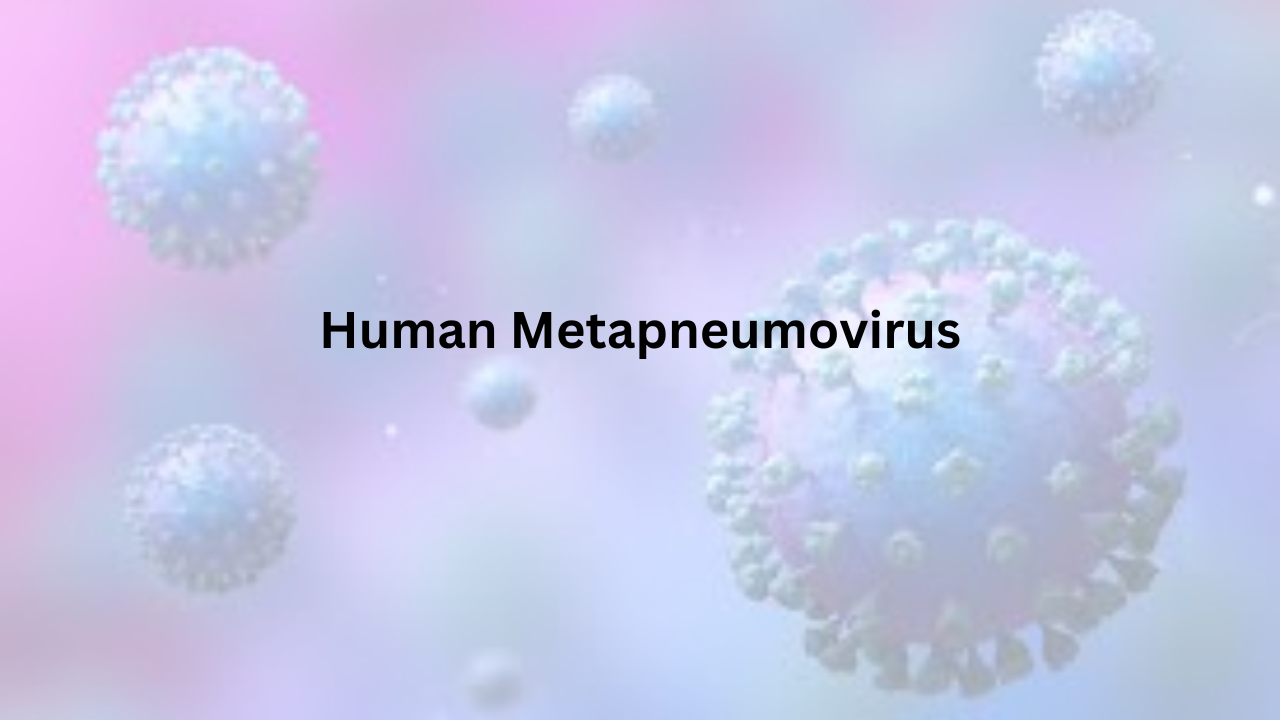Introduction to Human Metapneumovirus (HMPV)
Definition and Overview of Human Metapneumovirus (HMPV)
Human Metapneumovirus, often abbreviated as HMPV, is a virus that causes respiratory infections. It can lead to illnesses like the common cold, bronchitis, and pneumonia. People of all ages can get infected, but it’s most common in young children, older adults, and those with weakened immune systems.
Historical Discovery and Naming of Human Metapneumovirus
HMPV was first discovered in 2001 by Dutch scientists. They found it in children with respiratory illnesses. Studies showed that by the age of five, nearly all children have been exposed to HMPV.
Global Prevalence and Significance in Respiratory Infections
HMPV is found worldwide. In temperate regions, it often appears in late winter and early spring. It’s a common cause of respiratory infections, especially in children under five. In the United States, HMPV was responsible for 12% of cases of acute respiratory tract illness in otherwise-healthy children in a US outpatient clinic.
Key Facts about Human Metapneumovirus (HMPV)
| Aspect | Details |
|---|---|
| Discovery Year | 2001 |
| Common Age Groups Affected | Young children, older adults, and immunocompromised individuals |
| Seasonal Pattern | Peaks in late winter and early spring in temperate regions |
| Global Presence | Worldwide distribution |
| Common Illnesses Caused | Common cold, bronchitis, pneumonia |
| Percentage of Respiratory Illnesses in Children | 12% in U.S. outpatient clinics for acute respiratory tract illness in otherwise-healthy children |
Virology of Human Metapneumovirus (HMPV)
Taxonomy and Classification within the Pneumoviridae Family
Human Metapneumovirus (HMPV) belongs to the Pneumoviridae family, which includes viruses that cause respiratory infections. Within this family, HMPV is part of the Metapneumovirus genus. This classification is based on the virus’s structure and genetic makeup.
Genomic Structure and Characteristics
HMPV has a single strand of RNA as its genetic material. This RNA is “negative-sense,” meaning it must be converted into a positive form to make proteins. The virus’s RNA is wrapped in proteins that protect it and help in replication. These proteins include the nucleoprotein (N), phosphoprotein (P), and large polymerase protein (L).
Mechanisms of Viral Entry and Replication in Host Cells
HMPV infects cells in the respiratory tract. The virus uses two main proteins to enter these cells:
- Glycoprotein (G): Helps the virus attach to the surface of the host cell.
- Fusion Protein (F): Merges the virus’s outer layer with the host cell membrane, allowing the virus to enter.
Once inside, the virus releases its RNA into the cell’s cytoplasm. Here, the viral RNA is used to produce viral proteins and replicate the viral genome. New virus particles are then assembled and released to infect other cells.
Key Features of Human Metapneumovirus (HMPV)
| Feature | Description |
|---|---|
| Family | Pneumoviridae |
| Genus | Metapneumovirus |
| Genomic Material | Single-stranded negative-sense RNA |
| Key Proteins | Nucleoprotein (N), Phosphoprotein (P), Large Polymerase Protein (L), Glycoprotein (G), Fusion Protein (F) |
| Host Cell Entry Mechanism | Attachment via G protein; fusion and entry via F protein |
| Replication Site | Cytoplasm of host respiratory epithelial cells |
Epidemiology of Human Metapneumovirus (HMPV)
Seasonal Patterns and Geographic Distribution
Human Metapneumovirus (HMPV) is a virus that causes respiratory infections. It is found all over the world. In many places, HMPV infections happen more often in late winter and early spring. This pattern is similar to other viruses that cause colds and flu.
Incidence Rates Across Different Age Groups
HMPV can infect people of all ages. However, it is most common in young children and older adults. Studies have found that children under two years old are especially at risk. In one study, children between 6 and 8 months had the highest rate of HMPV infection.
Recent Outbreaks and Surveillance Data
Recently, there has been an increase in HMPV cases in China. In late 2024, HMPV was linked to 6.2% of positive respiratory illness tests and 5.4% of respiratory-illness hospitalizations in China, more than COVID-19, rhinovirus, or adenovirus. Health officials are watching the situation closely. They are also reminding people to practice good hygiene to help prevent the spread of the virus.
Key Epidemiological Features of Human Metapneumovirus (HMPV)
| Feature | Details |
|---|---|
| Seasonal Peak | Late winter to early spring |
| Global Presence | Worldwide distribution |
| High-Risk Age Groups | Children under 2 years, especially 6-8 months; older adults |
| Recent Outbreaks | Increased cases in China in late 2024 |
| Preventive Measures | Good hygiene practices, monitoring by health officials |
Clinical Manifestations of Human Metapneumovirus (HMPV)
Symptoms in Various Populations
Human Metapneumovirus (HMPV) is a virus that can cause respiratory illnesses in people of all ages. The symptoms can vary depending on the person’s age and health status.
- Children: In children, especially those under five years old, HMPV often causes symptoms similar to a cold. These include cough, runny nose, nasal congestion, sore throat, and fever. In some cases, it can lead to more serious conditions like bronchiolitis (inflammation of the small airways in the lung) or pneumonia (lung infection).
- Adults: Healthy adults usually experience mild symptoms such as cough, congestion, and sore throat. These symptoms typically resolve on their own without the need for medical treatment.
- Older Adults and Immunocompromised Individuals: In older adults and people with weakened immune systems, HMPV can cause more severe respiratory illnesses. Symptoms may progress to bronchitis or pneumonia, leading to difficulty breathing and wheezing. These individuals are at a higher risk for complications and may require medical attention
Differentiation from Other Respiratory Viruses
HMPV causes symptoms that are very similar to other respiratory viruses, such as the common cold, influenza (flu), and respiratory syncytial virus (RSV). This similarity makes it hard to tell the difference between these infections based on symptoms alone. For example, both HMPV and RSV can cause cough, runny nose, and wheezing. To accurately identify HMPV, healthcare providers may use specific laboratory tests that detect the virus in respiratory samples.
Potential Complications and Severity of Illness
While many HMPV infections are mild, the virus can lead to serious complications, especially in young children, older adults, and those with weakened immune systems. Potential complications include:
- Bronchiolitis: Inflammation of the small airways in the lungs, leading to breathing difficulties.
- Pneumonia: Infection of the lungs that can cause severe respiratory symptoms and may require hospitalization.
- Respiratory Failure: In severe cases, HMPV can lead to respiratory failure, a condition where the lungs cannot provide enough oxygen to the body.
It’s important to monitor symptoms and seek medical care if they worsen, especially in high-risk groups.
Overview of HMPV Clinical Manifestations
| Population Group | Common Symptoms | Potential Complications |
|---|---|---|
| Children | Cough, runny nose, nasal congestion, sore throat, fever | Bronchiolitis, pneumonia |
| Adults | Cough, congestion, sore throat | Rarely severe; complications are uncommon |
| Older Adults & Immunocompromised | Cough, difficulty breathing, wheezing, fever | Bronchitis, pneumonia, respiratory failure |
Diagnosis of Human Metapneumovirus (HMPV)
Human Metapneumovirus (HMPV) is a virus that causes respiratory infections. Diagnosing HMPV involves several methods to detect the virus in the body.
Diagnostic Methods
- Polymerase Chain Reaction (PCR): This test looks for the virus’s genetic material in samples from the nose or throat. PCR is very good at finding HMPV, even when there is only a small amount of the virus.
- Viral Culture: In this method, a sample from the patient is placed in a special environment to see if the virus grows. While accurate, this process takes longer and is less sensitive than PCR.
- Serology: This test checks for antibodies in the blood that fight HMPV. It helps determine if someone was infected in the past but is less useful for finding new infections.
Challenges in Early Detection and Misdiagnosis
Diagnosing HMPV early can be difficult because its symptoms, like cough and fever, are similar to other illnesses such as the flu or common cold. Without specific tests, doctors might mistake HMPV for another sickness. Additionally, not all hospitals have the tools to test for HMPV, which can lead to delays in finding the right diagnosis.
Advancements in Diagnostic Technologies
Newer methods are making it easier and faster to detect HMPV:
- Improved PCR Techniques: Modern PCR tests are quicker and can find even tiny amounts of the virus, helping doctors diagnose HMPV sooner.
- Rapid Antigen Tests: These tests can quickly detect parts of the virus in a sample, providing results faster than traditional methods.
- Multiplex Assays: These tests can find multiple viruses, including HMPV, at the same time. This is helpful when a patient might be sick with more than one virus.
Diagnostic Methods for HMPV
| Method | Description | Advantages | Limitations |
|---|---|---|---|
| PCR | Detects viral genetic material in respiratory samples | Highly sensitive and specific | Requires specialized equipment |
| Viral Culture | Attempts to grow the virus from patient samples | Accurate | Time-consuming; less sensitive |
| Serology | Measures antibodies against HMPV in the blood | Useful for identifying past infections | Not effective for early detection |
| Rapid Antigen Test | Identifies viral proteins in respiratory samples | Quick results | Lower sensitivity compared to PCR |
| Multiplex Assays | Simultaneously detects multiple respiratory viruses, including HMPV | Comprehensive; efficient | May require advanced laboratory facilities |
Early and accurate diagnosis of HMPV is important for proper care and to prevent the virus from spreading to others.
Treatment and Management of Human Metapneumovirus (HMPV)
Human Metapneumovirus (HMPV) is a virus that causes respiratory infections. Currently, there is no specific antiviral treatment or vaccine for HMPV. Therefore, managing the infection focuses on relieving symptoms and providing supportive care.
Current Therapeutic Approaches and Antiviral Options
- Supportive Care: Since no specific antiviral medications are available for HMPV, treatment primarily involves supportive measures to alleviate symptoms. This includes:
- Fever and Pain Management: Over-the-counter medications like acetaminophen or ibuprofen can help reduce fever and relieve body aches.
- Hydration: Maintaining adequate fluid intake is essential to prevent dehydration, especially in children and older adults.
- Rest: Encouraging rest helps the body fight off the infection more effectively.
- Oxygen Therapy: In severe cases where patients experience difficulty breathing, supplemental oxygen may be administered to maintain adequate oxygen levels.
- Mechanical Ventilation: For patients with severe respiratory distress, mechanical ventilation may be necessary to support breathing until they recover.
Considerations for High-Risk Populations
Certain groups are at higher risk for severe HMPV infections, including:
- Infants and Young Children: Due to their developing immune systems, they are more susceptible to severe respiratory symptoms.
- Older Adults: Aging can weaken the immune system, making older individuals more vulnerable to complications.
- Individuals with Underlying Health Conditions: People with chronic illnesses, such as asthma, chronic obstructive pulmonary disease (COPD), or heart disease, may experience worsened symptoms.
- Immunocompromised Individuals: Those with weakened immune systems, including cancer patients undergoing chemotherapy or individuals with HIV/AIDS, are at increased risk for severe disease.
Supportive Care Strategies
Supportive care aims to relieve symptoms and improve comfort during the illness. Strategies include:
- Humidified Air: Using a humidifier can help soothe irritated airways and reduce coughing.
- Saline Nasal Drops: These can alleviate nasal congestion, especially in young children who may have difficulty blowing their noses.
- Elevating the Head During Sleep: This can ease breathing by reducing nasal congestion and opening airways.
Overview of HMPV Treatment and Management
| Treatment Approach | Description |
|---|---|
| Supportive Care | Symptom relief through fever reducers, hydration, rest, and humidified air. |
| Oxygen Therapy | Supplemental oxygen for patients with low oxygen levels. |
| Mechanical Ventilation | Assisted breathing support in cases of severe respiratory distress. |
| High-Risk Population Considerations | Enhanced monitoring and early intervention for vulnerable groups, including infants, older adults, and immunocompromised individuals. |
Prevention and Control of Human Metapneumovirus (HMPV)
Human Metapneumovirus (HMPV) is a virus that causes respiratory infections. Preventing and controlling its spread is important to protect public health.
Vaccination Development and Challenges
Currently, there is no approved vaccine for HMPV. Developing a vaccine has been difficult due to several factors:
- Viral Complexity: HMPV has various strains, making it hard to create a vaccine that works against all types.
- Immune Response Understanding: Scientists are still learning how the body’s immune system responds to HMPV, which is crucial for vaccine development.
- Safety Concerns: Some experimental vaccines have shown side effects or were not effective enough, slowing progress.
Despite these challenges, research is ongoing. For example, scientists are exploring live attenuated vaccines, which use a weakened form of the virus to stimulate immunity. However, there are concerns about the virus regaining strength and causing illness.
Public Health Measures and Infection Control Practices
In the absence of a vaccine, public health measures are key to controlling HMPV:
- Hand Hygiene: Regular handwashing with soap and water helps remove germs. If soap and water are not available, using an alcohol-based hand sanitizer is effective.
- Surface Cleaning: Frequently touched surfaces, like toys and doorknobs, should be cleaned and disinfected regularly to reduce the risk of virus transmission. Civil Hub for Public Services
- Isolation of Infected Individuals: Keeping those who are sick away from others helps prevent the virus from spreading.
- Respiratory Hygiene: Covering the mouth and nose with a tissue or elbow when coughing or sneezing reduces the spread of droplets that may contain the virus.
Role of Personal Protective Equipment (PPE) and Hygiene
Personal protective equipment and good hygiene practices are essential in preventing HMPV transmission:
- Masks: Wearing masks can help prevent the spread of respiratory droplets, especially in crowded places or when caring for someone who is ill.
- Gloves and Gowns: Healthcare workers often use gloves and gowns to protect themselves when treating patients with HMPV.
- Hand Hygiene: Regular handwashing remains one of the most effective ways to prevent infection.
Key Measures for Preventing HMPV Transmission
| Measure | Description |
|---|---|
| Hand Hygiene | Wash hands regularly with soap and water; use alcohol-based hand sanitizer if soap is unavailable. |
| Surface Cleaning | Disinfect frequently touched objects and surfaces daily. |
| Isolation | Keep infected individuals away from healthy people to prevent spread. |
| Respiratory Hygiene | Cover mouth and nose when coughing or sneezing; dispose of tissues properly. |
| Use of PPE | Wear masks, gloves, and gowns as appropriate, especially in healthcare settings. |
Recent Developments and Research on Human Metapneumovirus (HMPV)
Human Metapneumovirus (HMPV) is a virus that causes respiratory infections. Recent studies have provided new insights into this virus.
Emerging Studies and Findings
Researchers have been studying HMPV to understand it better. They have found that HMPV is a leading cause of acute respiratory infections worldwide. Studies show that it affects people of all ages, especially young children and older adults.
Innovations in Treatment and Prevention
Currently, there is no specific treatment or vaccine for HMPV. However, scientists are working on developing vaccines and antiviral therapies. Recent research has led to the early stages of clinical trials for potential vaccines.
Global Health Initiatives and Collaborations
Health organizations worldwide are monitoring HMPV. They are working together to track the virus and develop strategies to control its spread. Public health measures, such as hand hygiene and respiratory etiquette, are promoted to prevent infections.
Key Facts about Human Metapneumovirus (HMPV)
| Aspect | Details |
|---|---|
| Discovery | Identified in 2001 by scientists in the Netherlands. |
| Symptoms | Causes respiratory symptoms like cough, fever, and nasal congestion. |
| At-Risk Populations | Young children, older adults, and individuals with weakened immune systems. |
| Seasonality | Often occurs in late winter and early spring. |
| Current Treatments | No specific antiviral treatment; care focuses on relieving symptoms. |
| Vaccine Status | No approved vaccine yet; research and clinical trials are ongoing. |
Conclusion
Human Metapneumovirus (HMPV) is a virus that causes respiratory infections. It leads to symptoms like cough, fever, and nasal congestion. Young children, older adults, and people with weak immune systems are more likely to get sick from it. Right now, there is no specific treatment or vaccine for HMPV. Doctors focus on relieving symptoms to help patients feel better.
Future Directions in HMPV Research and Public Health
Scientists are working hard to find better ways to fight HMPV. They are studying the virus to understand it more and are trying to create vaccines to prevent it. For example, new research has found antibodies that might help protect against HMPV.
Public health experts are also teaching people how to avoid getting sick. They suggest washing hands often, cleaning surfaces, and staying away from others when feeling ill. These steps can help stop the spread of HMPV.
Key Facts about Human Metapneumovirus (HMPV)
| Fact | Details |
|---|---|
| Discovery | Found in 2001 by scientists in the Netherlands. |
| Symptoms | Causes cough, fever, nasal congestion, and shortness of breath. |
| At-Risk Groups | Young children, older adults, and people with weak immune systems. |
| Seasonality | Happens more often in late winter and early spring. |
| Current Treatments | No specific treatment; care focuses on relieving symptoms. |
| Vaccine Status | No approved vaccine yet; research and clinical trials are ongoing. |



